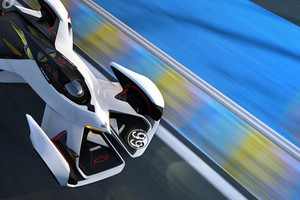
The Nissan IDS Concept unveiled today at the Tokyo Motor Show is the company’s vision of what cars will become in the near future. Central to that vision is autonomous driving, which Nissan says is close to becoming a reality.
Its plan is to roll out autonomous technology one piece at a time across its lineup, starting as early as next year in some markets. Vehicles fully capable of autonomous driving would be on sale by 2020.
The IDS Concept previews key engineering and design technology to be incorporated on future Nissan vehicles. This includes carbon-fiber construction, and a compact, aerodynamic shape, with fin-like vertical fenders front and rear to help the car cut efficiently through the air.
The IDS is an electric vehicle, but its 60 kilowatt-hour electric drive unit is still conceptual.
“By the time Nissan Intelligent Driving technology is available on production cars, EVs will be able to go great distances on a single charge,” Nissan design director Mitsunori Morita said in a press release announcing the IDS Concept. “Getting to this point will, of course, require the further evolution of batteries, but aerodynamic performance is also very important. We incorporated our most advanced aerodynamic technology in the design of the Nissan IDS Concept.”
The concept car further showcases potential solutions to one key challenge facing every automaker: how to enable autonomous cars to effectively communicate with pedestrians.
The solution Nissan has come up with on the IDS Concept involves an outward facing display screen in the dashboard that flashes messages like “After You,” to pedestrians and cyclists. Nissan also incorporated an “Intention Indicator”—a strip of LED lights along the side body that shine white when pedestrians or cyclists are nearby to indicate the car is aware of them.

The Nissan IDS Concept, a vision of autonomous driving in the future, made its public debut at the 2015 Tokyo Motor Show. (Credit: Matthew de Paula)
Like various experimental autonomous vehicles from other automakers, the Nissan IDS Concept’s interior morphs depending on the driving mode. In Manual Drive mode, the layout is similar to that of a regular car, with a digital instrument panel and steering wheel in front of the driver. In Piloted Drive mode, the steering wheel recedes into the dashboard, the car’s four seats angle slightly inward to create the effect of a lounge, and a large display panel the full width of the dashboard, which faces the interior in Manual Drive mode, flips around to face and projects the messages to pedestrians through the windshield.
Autonomous driving functions can be controlled by voice or gestures. A switch between the front seats called the PD Controller requires a physical action to toggle between Manual Drive and Piloted Drive—a step essential to safety, Nissan says.
Nissan did not say whether a production version of the IDS Concept is expected to be built, but some technology the car showcases definitely will inform future vehicles. Some form of the dashboard display screen that flips around to flash messages to pedestrians could be feasible in a production vehicle, a Nissan engineer said, but it’s too soon to tell whether something that complex could become a reality by the end of the decade.

Nissan says the technology showcased on its IDS Concept will make its way to production vehicles. (Credit: Matthew de Paula)
Nissan also unveiled another concept car at the Tokyo Motor Show called Teatro for Dayz. This small hatchback was created with young people who will soon be old enough to drive—a group Nissan refers to as “share natives.” As such, this concept incorporates features that allow occupants to create and share experiences digitally with friends both onboard and online.
Though the spotlight at many auto shows is on production cars, Tokyo is best known for its concept cars, many of which are truly wacky. To see the most interesting concepts from Tokyo last time around, click here.
